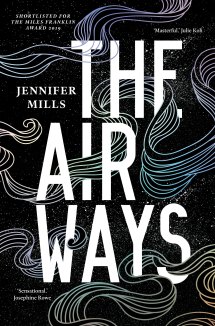This was published 3 years ago
Every breath you take ... could lead to disaster
By Jack Cameron Stanton
FICTION
The Airways
Jennifer Mills
Picador, $32.99
Dyschronia by Jennifer Mills was an eerie and atmospheric novel about the sudden disappearance of the ocean at an Australian coastal town. Its title, an invented illness, refers to the protagonist’s ability to perceive time “funny”, between the past, present and future. Rather than whimsical, a la Vonnegut’s Slaughterhouse-Five, or the scientific romance of H.G. Wells’ Time Machine, Mills’ time-bending was a deeply unsettling, neo-Gothic take on ecological instability.
Her latest novel, The Airways, uses the same uncanny dream logic for a queer ghost story about haunted souls.
Yun, a non-binary student in Sydney, is murdered footsteps away from their share house. Although the murderer is never caught, Yun’s ghost rises from their dead body and learns how to inhabit the living by entering through their airways. In their astral state, Yun pursues Adam, an ex-roommate who wronged them in the past.
Adam watches people while they sleep. Sometimes he films them. When they lived together, Yun discovered Adam’s sleazy, predatory impulses: “Adam had disturbed my surfaces.”

Jennifer Mills has written a ghost story about haunted souls.Credit:
After Yun’s death, Adam flees Sydney to Beijing, where he hopes to escape his past. There he is afflicted by dissociation, memory loss and an amorphous fever that gives “the sense of something living under his skin”. Meanwhile, Yun seeks vengeance; a classic tale of hunter becoming the hunted: “In the contained air, thick with transmission, they shutter from body to body, feeding on attention, on distraction, seeking him out.”
The stories of our two flaneurs (one disembodied, the other human) stretch across alternating storylines. In Beijing, Adam, alone and wayward, roams smog-riddled streets, unable to shake the feeling he’s being watched. Yun’s ghost inhabits the living like a parasite. They discover that they can invade bodies via their breath, and eventually devise ways of controlling people from inside, making their presence known in the physical world.
The third storyline follows Adam in Sydney, before departing for Beijing, where he anxiously tries to justify his sick, invasive fetish.
Like the Miles Franklin short-listed Dyschronia, The Airways achieves its uncanny atmosphere by obscuring or suspending plot details. Likewise important events are de-emphasised and occur in ellipsis or fragment. The result is that the climactic moments – Yun’s murder, Adam’s transgressions – occur off the page or in high-register poetic abstraction.

Credit:
Yun’s death, for instance, is told in impressionistic stanza: “fall, falling. Back of the head / (grunts and drunks scents, sweat) / the eyes went for a white moment, contents tipped out, nonsense / (what sharp rip this) / the sense of harm arrived before pain / (and gut. two or. laughing or) / so violence seemed continuous with being.”
At times Mills’ thematic explorations precede story. Nowhere is this more evident than in the glut of references to “body/bodies” and “air”. Especially in the Yun sections, where humans are defamiliarised into “bodies”, the repetition of the above-offenders overrides scenes with weighty symbolism.
And yet, Mills’ meditations produce fresh prose: “they can no more go back into that house than smoke can enter charcoal and make a tree grow,” Yun’s ghost laments. “Once he had begun to avoid the street, those few blocks, it was easy to make the whole suburb disappear, to carve out a segment of the city and abandon it to some unreachable place in history,” Adam reflects.
Mills’ characters are amid radical transformation. Adam’s periods of blackout and lost time allude to the possibility of a double-life, a second self “shifting in and out of himself”. Why does he feel guilt about Yun’s murder? Could he have been involved, more than he knows? Why else would Yun’s ghost travel from Sydney to Beijing to hunt down and possess him?
The dead can have existential crises too. As a ghost, Yun is alert to life, wanting “to claw my way out of the earth, out of this shell. To become something else, something as yet unseen, untethered”, which may be a cryptic reference to coming out as non-binary.
“Where does desire end, and violence begin?” Yun asks, near the novel’s end. This question is the crux of The Airways. Although we do not receive a direct response, it poses interesting possibilities about the nature of revenge. Will Yun’s eye-for-an-eye quest cause them to descend to Adam’s level? A parasite that feeds off its host?
The Airways has the dual effect of resonating long after the fact, but also proving at times disorientating and porous. Returning to Vonnegut, I was struck by his “rule” for writing: “Give your readers as much information as possible as soon as possible. To heck with surprise.” Simple enough, but of course, conditional. In defiance of Vonnegut, Mills has achieved a sense of bewilderment by encrypting her straightforward plot with allusive, visceral and often repetitive imagery.